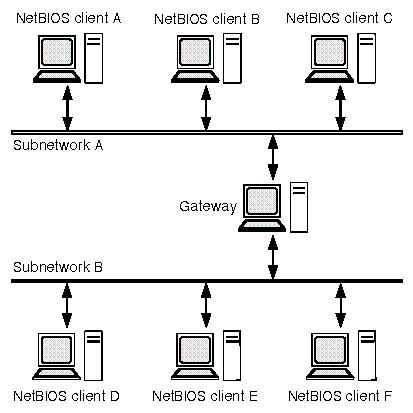
|
|
When NetBIOS was originally designed and implemented, it was envisaged that it would only be required to run on individual LANs. What was not envisaged was the explosion in use of LANs and the resulting connectivity options that are now available. It is not unusual for LANs to be interconnected via gateways, that is, machines that have connections to more than one LAN (or subnetwork as it is technically known) and have software to route information between networks. This is shown in the figure shown below.

NetBIOS subnetworks
As it was originally implemented NetBIOS could not work across this gateway. For example, if ``NetBIOS Client A'' wants to use a service on ``NetBIOS Client C'', this is no problem as both clients are on the same subnetwork (Subnetwork A). However, if ``Client A'' wants to use a service on ``Client E'', this would not work under the original versions of NetBIOS.
SCO NetBIOS now supports connection to multiple subnetworks. Providing NetBIOS is configured correctly, services on one subnetwork can be made available to NetBIOS clients on another subnetwork.
To locate the names and locations of NetBIOS services, SCO NetBIOS now also supports the use of DNS (Domain Name System) and WINS (Windows Internet Naming Service). Previously, if a service name could not be found in the local NetBIOS name table, a broadcast message was sent out on the attached subnetwork. The drawback of this was that only a directly attached subnetwork could be searched using a broadcast. If the service was on a remote subnetwork, it would not be found.
A host can be configured to find out the names and locations of NetBIOS services in the following ways: